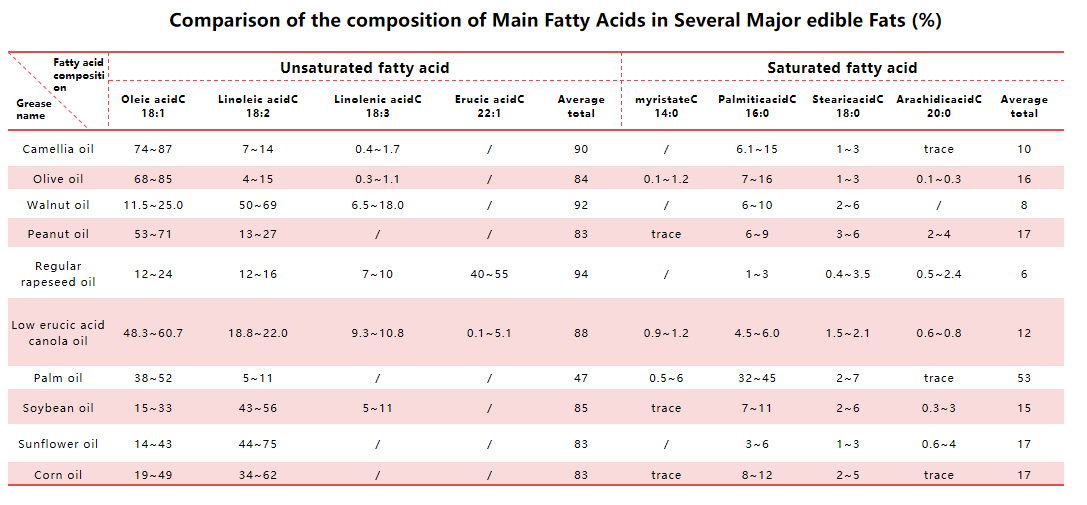Tea oil effect
FAO, the Food and Agriculture Organization of the United Nations, issued the "Standards for Healthy Edible Oils" and pointed out that the most reasonable intake ratio of fatty acids in healthy edible oils is: less than 10% of saturated fatty acids and more than 75% of monounsaturated fatty acids; among essential fatty acids, the ratio of linolenic acid and linoleic acid is The ratio is less than or equal to 1:4. The fatty acid composition of camellia oil best meets this standard; therefore, camellia oil is the most ideal healthy edible oil.
The saturated fatty acid content in camellia oil is around 10% (see table below), which is at a low level among various major edible fats and oils. It is even lower than olive oil, which is known as "liquid gold", and is lower than the international nutritional standards. The definition of saturated fatty acid content is 12%. Therefore, in terms of saturated fatty acid content alone, tea oil is a healthy edible oil. In addition, the ratio of linoleic acid and linolenic acid in camellia oil is also close to the ratio recommended by the Chinese Nutrition Society, and long-term consumption is very beneficial to human health.

Oleic acid is a monounsaturated fatty acid. A large number of medical experiments have proven that consuming oils mainly composed of monounsaturated fatty acids can reduce the content of low-density lipoprotein cholesterol (a kind of "bad" cholesterol) in the body, while maintaining or even increasing high-density lipoprotein cholesterol (a kind of "bad" cholesterol). "good" cholesterol) content. The oleic acid content in camellia oil is generally between 74% and 87%, and is basically stable at around 80%, which is the highest among all major edible oils at present.
Therefore, consuming camellia oil can help reduce cholesterol in blood lipids and reduce the deposition of cholesterol on blood vessel walls, thereby preventing arteriosclerosis and increased blood pressure. According to foreign epidemiological surveys, there is a significant negative correlation between dietary monounsaturated fatty acids and mortality from coronary heart disease. Medical workers believe that the lower mortality rate from coronary heart disease in some areas is related to the daily consumption of oils rich in monounsaturated fatty acids, such as olive oil, tea oil and other oils. Therefore, camellia oil is an edible vegetable oil strongly promoted in the "Outline of China's Food Structure Reform and Development".
Generally speaking, the higher the oleic acid content and the lower linoleic acid and linolenic acid content in vegetable oil, the better its oxidation stability. The oleic acid content of camellia oil is as high as about 80%, and the linoleic acid and linolenic acid content only account for about 10%. After the impurities and moisture are removed from the camellia oil, it can remain at room temperature for several years without deterioration. Therefore, camellia oil is not easily oxidized and is resistant to storage. This characteristic of camellia oil makes it an excellent raw material for canned oil-soaked foods. Its freshness and shelf life are 2 to 3 times longer than canned food soaked in other oils.
-
(1) Squalene: The squalene content in camellia oil is: 100~200 mg/100 g. Its main functions:
① Improve the vitality of brain cells, help eliminate fatigue, prevent and treat headaches, migraines, and improve sleep.
② Improve circulation, neutralize the hydrogen ions in the blood to reduce the acidity of the blood, normalize the pH of the blood, and thereby achieve the function of purifying the blood.
③Strengthens the liver and has a health care effect on hepatitis and fatty liver.
④ Enhance immunity, prevent and treat tumors.
⑤ Beautify the skin, moisturize and remove wrinkles. -
(2) Vitamin E: The content of vitamin E in camellia oil is: 10~70 mg/100g. Its main functions:
① Reduce symptoms of atherosclerosis, headache, insomnia, dizziness, tinnitus and other symptoms, and lower blood pressure, blood lipids and cholesterol.
② Control the growth of tumor cells and reduce the probability of tumor occurrence in the body.
③ It has a good effect on treating habitual abortion, female infertility, endocrine dysfunction, liver disease, etc.
④ Natural vitamin E is easily absorbed by the skin, can promote skin metabolism, prevent pigmentation, improve skin elasticity, and has special functions of beauty, skin care, and anti-aging.
⑤ Delay Alzheimer’s disease and central nervous system dysfunction.
Vitamin E is very important for the development of the nervous system, and is of great significance for nerve coordination and motor function. The main role of vitamin E here is to prevent the oxidation of fatty acids, maintain the activity and metabolism of cell membranes, and thereby delay aging. -
(3) Sterols: The content of phytosterols in tea oil is up to 600 mg/100 g.
① Its main function is: known as the "cholesterol nemesis". A daily intake of 1.3 grams of plant sterol esters (equivalent to 767 mg of plant sterols) can lower cholesterol. The more intake, the better the cholesterol-lowering effect.
②Prevent and treat prostate diseases. Phytosterols have certain positive significance in reducing the incidence of prostatic hypertrophy and prostate cancer in men.
③As an anti-cancer substance. Phytosterols have a certain inhibitory effect on the occurrence and development of certain cancers in the body, such as breast cancer, gastric cancer, intestinal cancer, etc.
④Others. Anti-inflammatory, immunomodulatory, anti-viral, etc.
Among them, the functions of lowering blood cholesterol and preventing and treating prostate diseases have attracted widespread attention and have been applied in practice. -
(4) Polyphenols
① It has strong free radical elimination and anti-aging effects.
②Has inhibitory effect on cancer cells.
③It has antibacterial and bactericidal effects.
④ It has an inhibitory effect on HIV.
⑤Natural antioxidants. Its antioxidant capacity is 4 to 6 times that of synthetic antioxidants BHT and BHA, 6 to 7 times that of vitamin E, and 5 to 10 times that of vitamin C. This is closely related to the fact that camellia oil is not easily oxidized and rancid.












